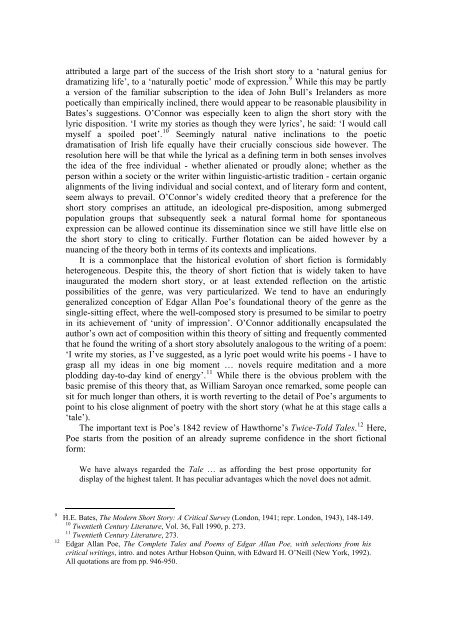Inside Out: A Working Theory of the Irish Short Story. John Kenny
Inside Out: A Working Theory of the Irish Short Story. John Kenny
Inside Out: A Working Theory of the Irish Short Story. John Kenny
You also want an ePaper? Increase the reach of your titles
YUMPU automatically turns print PDFs into web optimized ePapers that Google loves.
attributed a large part <strong>of</strong> <strong>the</strong> success <strong>of</strong> <strong>the</strong> <strong>Irish</strong> short story to a ‘natural genius for<br />
dramatizing life’, to a ‘naturally poetic’ mode <strong>of</strong> expression. 9 While this may be partly<br />
a version <strong>of</strong> <strong>the</strong> familiar subscription to <strong>the</strong> idea <strong>of</strong> <strong>John</strong> Bull’s Irelanders as more<br />
poetically than empirically inclined, <strong>the</strong>re would appear to be reasonable plausibility in<br />
Bates’s suggestions. O’Connor was especially keen to align <strong>the</strong> short story with <strong>the</strong><br />
lyric disposition. ‘I write my stories as though <strong>the</strong>y were lyrics’, he said: ‘I would call<br />
myself a spoiled poet’. 10 Seemingly natural native inclinations to <strong>the</strong> poetic<br />
dramatisation <strong>of</strong> <strong>Irish</strong> life equally have <strong>the</strong>ir crucially conscious side however. The<br />
resolution here will be that while <strong>the</strong> lyrical as a defining term in both senses involves<br />
<strong>the</strong> idea <strong>of</strong> <strong>the</strong> free individual - whe<strong>the</strong>r alienated or proudly alone; whe<strong>the</strong>r as <strong>the</strong><br />
person within a society or <strong>the</strong> writer within linguistic-artistic tradition - certain organic<br />
alignments <strong>of</strong> <strong>the</strong> living individual and social context, and <strong>of</strong> literary form and content,<br />
seem always to prevail. O’Connor’s widely credited <strong>the</strong>ory that a preference for <strong>the</strong><br />
short story comprises an attitude, an ideological pre-disposition, among submerged<br />
population groups that subsequently seek a natural formal home for spontaneous<br />
expression can be allowed continue its dissemination since we still have little else on<br />
<strong>the</strong> short story to cling to critically. Fur<strong>the</strong>r flotation can be aided however by a<br />
nuancing <strong>of</strong> <strong>the</strong> <strong>the</strong>ory both in terms <strong>of</strong> its contexts and implications.<br />
It is a commonplace that <strong>the</strong> historical evolution <strong>of</strong> short fiction is formidably<br />
heterogeneous. Despite this, <strong>the</strong> <strong>the</strong>ory <strong>of</strong> short fiction that is widely taken to have<br />
inaugurated <strong>the</strong> modern short story, or at least extended reflection on <strong>the</strong> artistic<br />
possibilities <strong>of</strong> <strong>the</strong> genre, was very particularized. We tend to have an enduringly<br />
generalized conception <strong>of</strong> Edgar Allan Poe’s foundational <strong>the</strong>ory <strong>of</strong> <strong>the</strong> genre as <strong>the</strong><br />
single-sitting effect, where <strong>the</strong> well-composed story is presumed to be similar to poetry<br />
in its achievement <strong>of</strong> ‘unity <strong>of</strong> impression’. O’Connor additionally encapsulated <strong>the</strong><br />
author’s own act <strong>of</strong> composition within this <strong>the</strong>ory <strong>of</strong> sitting and frequently commented<br />
that he found <strong>the</strong> writing <strong>of</strong> a short story absolutely analogous to <strong>the</strong> writing <strong>of</strong> a poem:<br />
‘I write my stories, as I’ve suggested, as a lyric poet would write his poems - I have to<br />
grasp all my ideas in one big moment … novels require meditation and a more<br />
plodding day-to-day kind <strong>of</strong> energy’. 11 While <strong>the</strong>re is <strong>the</strong> obvious problem with <strong>the</strong><br />
basic premise <strong>of</strong> this <strong>the</strong>ory that, as William Saroyan once remarked, some people can<br />
sit for much longer than o<strong>the</strong>rs, it is worth reverting to <strong>the</strong> detail <strong>of</strong> Poe’s arguments to<br />
point to his close alignment <strong>of</strong> poetry with <strong>the</strong> short story (what he at this stage calls a<br />
‘tale’).<br />
The important text is Poe’s 1842 review <strong>of</strong> Hawthorne’s Twice-Told Tales. 12 Here,<br />
Poe starts from <strong>the</strong> position <strong>of</strong> an already supreme confidence in <strong>the</strong> short fictional<br />
form:<br />
We have always regarded <strong>the</strong> Tale … as affording <strong>the</strong> best prose opportunity for<br />
display <strong>of</strong> <strong>the</strong> highest talent. It has peculiar advantages which <strong>the</strong> novel does not admit.<br />
9<br />
H.E. Bates, The Modern <strong>Short</strong> <strong>Story</strong>: A Critical Survey (London, 1941; repr. London, 1943), 148-149.<br />
10<br />
Twentieth Century Literature, Vol. 36, Fall 1990, p. 273.<br />
11<br />
Twentieth Century Literature, 273.<br />
12<br />
Edgar Allan Poe, The Complete Tales and Poems <strong>of</strong> Edgar Allan Poe, with selections from his<br />
critical writings, intro. and notes Arthur Hobson Quinn, with Edward H. O’Neill (New York, 1992).<br />
All quotations are from pp. 946-950.

















